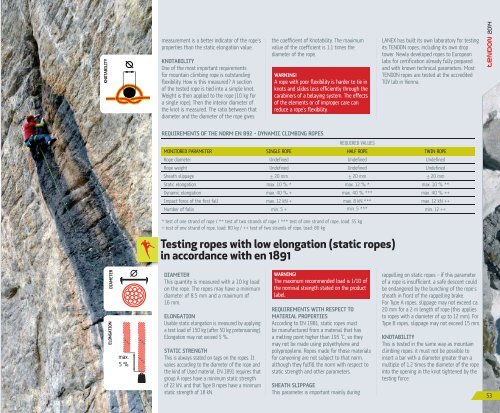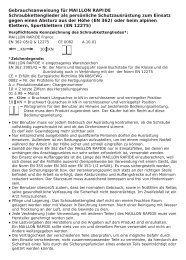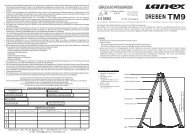static ropes - Aliens Bergsport
static ropes - Aliens Bergsport
static ropes - Aliens Bergsport
Create successful ePaper yourself
Turn your PDF publications into a flip-book with our unique Google optimized e-Paper software.
2014<br />
KNOTABILITY<br />
measurement is a better indicator of the rope’s<br />
properties than the <strong>static</strong> elongation value.<br />
KNOTABILITY<br />
One of the most important requirements<br />
for mountain climbing rope is outstanding<br />
flexibility. How is this measured? A section<br />
of the tested rope is tied into a simple knot.<br />
Weight is then applied to the rope (10 kg for<br />
a single rope). Then the interior diameter of<br />
the knot is measured. The ratio between that<br />
diameter and the diameter of the rope gives<br />
the coefficient of Knotability. The maximum<br />
value of the coefficient is 1.1 times the<br />
diameter of the rope.<br />
WARNING!<br />
A rope with poor flexibility is harder to tie in<br />
knots and slides less efficiently through the<br />
carabiners of a belaying system. The effects<br />
of the elements or of improper care can<br />
reduce a rope’s flexibility.<br />
LANEX has built its own laboratory for testing<br />
its TENDON <strong>ropes</strong>, including its own drop<br />
tower. Newly developed <strong>ropes</strong> to European<br />
labs for certification already fully prepared<br />
and with known technical parameters. Most<br />
TENDON <strong>ropes</strong> are tested at the accredited<br />
TÜV lab in Vienna.<br />
REQUIREMENTS OF THE NORM EN 892 – DYNAMIC CLIMBING ROPES<br />
REQUIRED VALUES<br />
MONITORED PARAMETER SINGLE ROPE HALF ROPE TWIN ROPE<br />
Rope diameter Undefined Undefined Undefined<br />
Rope weight Undefined Undefined Undefined<br />
Sheath slippage ± 20 mm ± 20 mm ± 20 mm<br />
Static elongation max. 10 % * max. 12 % * max. 10 % **<br />
Dynamic elongation max. 40 % + max. 40 % *** max. 40 % ++<br />
Impact force of the first fall max. 12 kN + max. 8 kN *** max. 12 kN ++<br />
Number of falls min. 5 + min. 5 *** min. 12 ++<br />
* test of one strand of rope / ** test of two strands of rope / *** test of one strand of rope, load: 55 kg<br />
+ test of one strand of rope, load: 80 kg / ++ test of two strands of rope, load: 80 kg<br />
Testing <strong>ropes</strong> with low elongation (<strong>static</strong> <strong>ropes</strong>)<br />
in accordance with en 1891<br />
DIAMETER<br />
ELONGATION<br />
max.<br />
5 %<br />
DIAMETER<br />
This quantity is measured with a 10 kg load<br />
on the rope. The <strong>ropes</strong> may have a minimum<br />
diameter of 8.5 mm and a maximum of<br />
16 mm.<br />
ELONGATION<br />
Usable <strong>static</strong> elongation is measured by applying<br />
a test load of 150 kg (after 50 kg pretensioning).<br />
Elongation may not exceed 5 %.<br />
STATIC STRENGTH<br />
This is always stated on tags on the <strong>ropes</strong>. It<br />
varies according to the diameter of the rope and<br />
the kind of Used material. EN 1891 requires that<br />
group A <strong>ropes</strong> have a minimum <strong>static</strong> strength<br />
of 22 kN, and that Type B <strong>ropes</strong> have a minimum<br />
<strong>static</strong> strength of 18 kN.<br />
WARNING!<br />
The maximum recommended load is 1⁄10 of<br />
the nominal strength stated on the product<br />
label.<br />
REQUIREMENTS WITH RESPECT TO<br />
MATERIAL PROPERTIES<br />
According to EN 1981, <strong>static</strong> <strong>ropes</strong> must<br />
be manufactured from a material that has<br />
a melting point higher than 195 °C, so they<br />
may not be made using polyethylene and<br />
polypropylene. Ropes made for those materials<br />
for canyoning are not subject to that norm,<br />
although they fulfill the norm with respect to<br />
<strong>static</strong> strength and other parameters.<br />
SHEATH SLIPPAGE<br />
This parameter is important mainly during<br />
rappelling on <strong>static</strong> <strong>ropes</strong> – if this parameter<br />
of a rope is insufficient, a safe descent could<br />
be endangered by the bunching of the rope’s<br />
sheath in front of the rappelling brake.<br />
For Type A <strong>ropes</strong>, slippage may not exceed ca.<br />
20 mm for a 2 m length of rope (this applies<br />
to <strong>ropes</strong> with a diameter of up to 12 mm). For<br />
Type B <strong>ropes</strong>, slippage may not exceed 15 mm.<br />
KNOTABILITY<br />
This is tested in the same way as mountain<br />
climbing <strong>ropes</strong>: it must not be possible to<br />
insert a bar with a diameter greater than a<br />
multiple of 1.2 times the diameter of the rope<br />
into the opening in the knot tightened by the<br />
testing force.<br />
53






